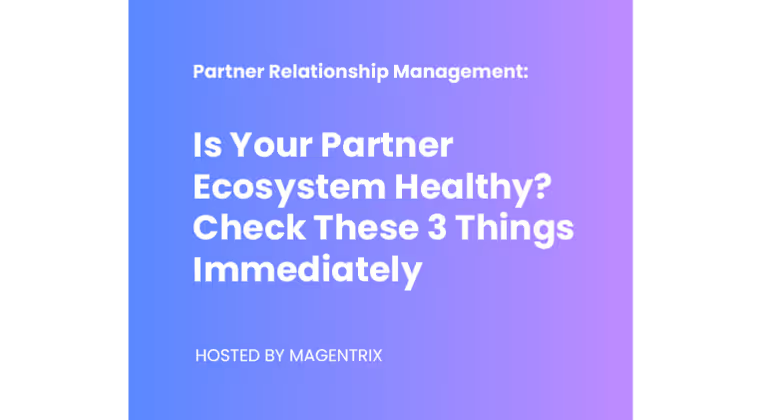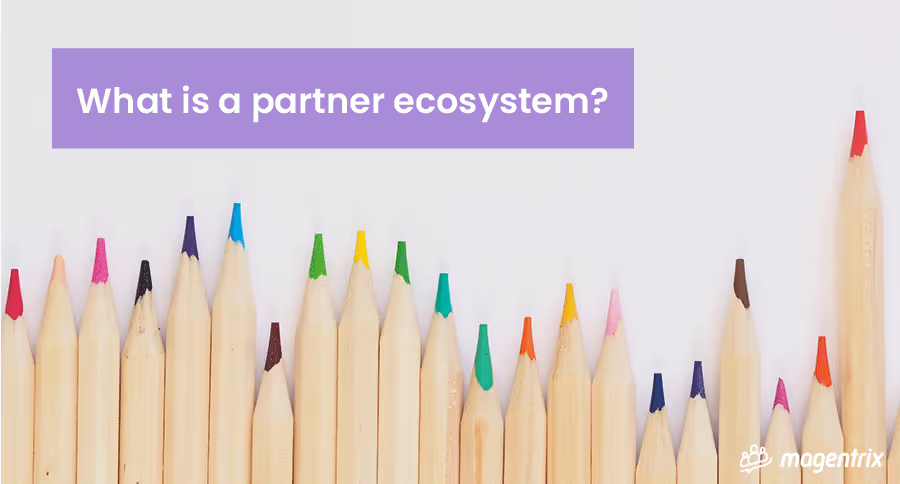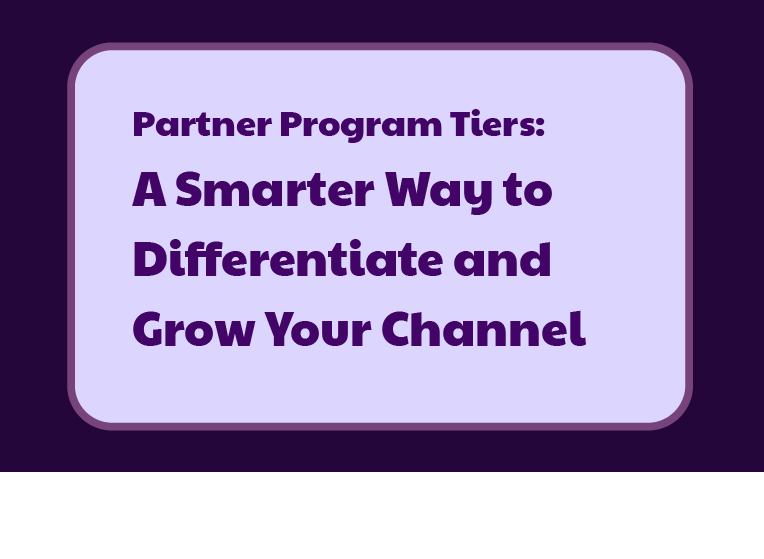- Introduction
- The evolution of partnerships and ecosystems
- The shift to the ecosystem model
- Gauging the health of the ecosystem – how it impacts the success of partnerships
- Establishing a Partner Ecosystem
- 1st Thing to Check: Ecosystem strategy
- 2nd Thing to Check: Interaction and engagement amongst partners
- 3rd Thing to Check: Mutual benefits for partners
- CWhat results can you expect from a healthy ecosystem
- Norma Watenpaugh’s background in partner ecosystems
Is Your Partner Ecosystem Healthy? Check These 3 Things Immediately
How do you know if your partner ecosystem is healthy? Find out what can you track to gauge the health of your ecosystem before it’s too late.

Table of Contents 📋
September 7, 2022
The Ultimate Channel Sales PodcastTable of Contents 📋
Listen to the podcast with guest speaker: Norma Watenpaugh of Phoenix Consulting Group. Aired on August 31, 2022.
Today’s partnerships are a diverse ecosystem of interacting parts.
In school, we learned that healthy ecosystems are vital to survival. Ecosystems are, at times, fragile, but if kept healthy, can sustain long-term growth.
In modern partner organizations, interconnectedness spurs growth.
Partner ecosystems are like ecological ones; when healthy, all connected parts can nurture and support one another.
- But how do you know if your partner ecosystem is healthy?
- Are there any measurements that can help monitor ecosystem health?
- And how can you identify deficiencies within your ecosystem before it’s too late?
Forrester writes that ecosystem metrics must be more than transactional reporting alone. Now, more than ever, partner organizations need to prove the business impact of their ecosystems.
Consider today’s episode your ecosystem pulse check. Listen in to find out:
- How you can sustain a healthy partner ecosystem
- What you can do to optimize ecosystem health
- And then, we’ll take a look at examples of some of today’s thriving partner ecosystems.
Today's guest, Norma Watenpaugh, has really been a visionary in the IT world for channel giants like Sun Microsystems, pre-Oracle, Fujitsu, BA Systems, and for the last 20 years, CEO and founding partner of the Phoenix Consulting Group.
She has a laser focus on helping companies achieve profitable results through strategic alliances, channels, and partner ecosystems. And she's recently published a very interesting article on, “How Do You Know If Your Partner Ecosystem Is Healthy?” and we thought we would have her on the show to take a deeper dive into some of these concepts.
She's with us today to talk about: the three things you can immediately do to keep your partner ecosystem healthy.
Norma Watenpaugh: I first called the larger partner community an ecosystem over 20 years ago. My boss at the time was one of these hard-charging, no-nonsense sales guys and he looked at me like Iit was a tree hugger. In fact, I think he called me a tree hugger.
But at the time, it was becoming apparent that we had these silos of partners we manage: channels, and technology, and SI’s. And we kept them in their neat little niches because it was easiest for us to manage.
It really didn't take into account that, that's not how customers saw them. And that's not how they saw themselves. They had much more diverse business models than what we were giving them credit for.
I think in the last 20 years more people have come to realize, particularly as the business dynamics changed, in say, the channel, where channel partners don't make all their money on margins anymore, they have blended revenue streams.
They have to have services. They have to have their own IP. This just means that they don't stay in their neat little boxes.
What is a partner ecosystem?

Paul Bird: Since it is a topic that's been quite hot over the last couple of years, I know that a lot of people are still having trouble understanding what an ecosystem is.
If we start right at the basics, in a nutshell, can you define: what is a partner ecosystem?
Norma Watenpaugh: I like to fall back on the biological definition. It's a community of interacting organisms and their environment.
A partner ecosystem follows the definition of the biological one:
an interactive community of organisms.
I think it has a lot of value and validity here because you need to think of your partners as organisms: living, breathing, changing, adapting, things.
And one of the definitions of a living organism is that they are adaptive to change. Or they don't continue.
That has been very true of the VAR channel over the last 10 years. They haven’t kept up to date with the changes with SaaS and disruption and whatnot.
They've either changed into a very different animal or they've hung up their shingle and went off to retire.
An interacting and interconnected community
“It's important to think of partners as being very dynamic business entities and interacting.”
That might be the very essential difference in how we talk about our partner communities.
Traditionally, we set up our channels and technology programs as a hub and spoke. In which, you have a central company platform in the center, doing all the orchestrations.
There are a lot of one-to-one relationships but we really didn't encourage or promote the interconnections within that community.
When you talk about a living ecosystem, everything in that ecosystem has a relationship or an interaction with everything else in that and an interdependency.
Of course, there are predators and there are all sorts of behaviors going on in the ecosystem.
Paul Bird: Why do you think people are moving to this model now?
By the sounds of it, this has been around for a long time, but it looks like there's more of a movement towards recognizing that you do have an ecosystem and they're trying to move their model to it.
Why now, as opposed to 20 years ago?
What and how consumers buy is more complex
Norma Watenpaugh: The way customers buy has become more complex. And the things that they buy have become more complex.
If you're buying an IoT solution, or a digital transformation, or you're trying to improve your customer experience, those are always multi-vendor solutions.
Customers don't want to buy a bag of parts in some assembly required. A few do, but most don't.
“They want to buy a business outcome. They want to get to better profitability, or better revenue generation. Or better differentiation within their market.”
They're buying an outcome not, as I said, a bag of parts or a lot of technology. They want it all assembled, and they want it to work, and most of it is in the cloud these days.
That's why it's driven the notion that we have to have tighter ecosystems because we're going to market to seek assistance.
We're building these solutions stacks. And we always had them, what we call marketectures, where we stacked all this partner tech together.
But we didn't do the really hard work of ensuring they all work together, we went to market together and we could support our customers collaboratively.
Paul Bird: Why do you think it's so important to measure the health and gauge the health of these ecosystems?
What role do you play in the partnership and how does that really go for gauging how healthy and productive these ecosystems are?
Norma Watenpaugh: We've talked about some of the differences of an ecosystem versus our traditional programs.
In the traditional program sweep, we've learned how to metric those and measure value. But it's more than a sum of the parts.
Especially when you talk about an ecosystem because I believe the value is generated in those interconnections, in the community.
The ability for those individual partners to come together and form solutions, to go-to-market together, to create greater value for customers together. We're not really measuring that.
When I think about those three things I would say they are unique to ecosystems and what we should actually be measuring to determine their health:
1. Are they scaling growth for you?
- Are they collaborating together to create better opportunities for you?
2. An ability to innovate
- Two minds are greater than one. If you have multiple partners in a solution, you have all of those partners thinking of innovation, bringing what they know, their unique differences and perspectives to innovate around a customer solution.
3. Partner economics: The partner health, in terms of, the economics.
- As we noticed before, partners aren't staying in their neat little boxes anymore.
- You need to look at:
- What is their revenue model?
- And are those revenue models fully activated within your ecosystem?
- And what are you doing to enable partners, not just to make a reasonable margin (which is probably the least of their profit streams)?
- Can they get that five X multiplier on services?
- Can they insert unique IP?
- Whether it is productized services or connectors or accelerators or extensions to your product to create additional revenue streams for them.
- Whether it is productized services or connectors or accelerators or extensions to your product to create additional revenue streams for them.
So those are three things:
- Growth
- Innovation
- And the economics
Paul Bird: Financial health is critical.
If your ecosystem, if your partners, are not making money around your solution, they're not going to build a practice around it, and they'll find another one that will.
Traditional metrics don’t apply when measuring the success of your ecosystem
Paul Bird: In the article, you say, “Traditional metrics used for one-to-one partnerships or even one-to-many do not suffice when we look at the many-to-many dynamic.” – can you expand on that a little bit?
Why are the traditional metrics not effective when we're looking at ecosystem partners, if we're trying to focus on growth at scale, innovation, and this financial health model.
Norma Watenpaugh: Some are. You’re still going to measure what the net revenue generation is of your ecosystem.
But there are other things along the way that I think will help you understand if it's healthy and what to optimize.
One thing that I have found is that when you measure the impact of partner sales, of co-selling, when you have one or more partners working together on an opportunity.
Companies that really put some rigor around tracking this, are finding:
- bigger deals
- faster close rates
- higher close rates
One, in particular, that I tapped on just a few weeks ago to see how they were doing, was reporting:
- double the deal size 40%
- acceleration 50%,
- higher close rates
Now, apply that to your pipeline. Your CRO and board are going to be very happy with you.
But then, what happens if you can enable that level of collaboration among your partners in the ecosystem, not just on what you do, but you now have an ecosystem of collaborating partners that can come together and generate that kind of growth and scale.

Channel conflict & partner ecosystems
Paul Bird:As I have talked to people in channel leadership positions, everyone wants to talk about channel conflict.
There is resistance to allowing collaborative relationships between partnerships.
So, when you look at an ecosystem, how does channel conflict work into that and is channel conflict simply a thing of the past?
Norma Watenpaugh: When you bring 3 or 4 partners together in an opportunity, there's probably going to be overlap in what they do.
Does that mean you don't do it?
If there's revenue to be had, you're going to figure it out.
And co-opetition is an advanced art, I get that.
Collaborate with partners in your ecosystem to create the most value for customers
Norma Watenpaugh: You have to realize that it's bigger than one deal. Your collaboration, hopefully, if you’re doing it right, is going to be repeatable.
You have to figure out your swim lanes. And what I find is that ultimately, if you put the customer in the center of that, how do you create more value? You increase your close rate for one thing.
Certainly, a percentage of a sale is better than none of it.
“You have to look at it from the perspective of: how are you creating value for customers and where do you create the best value versus others in your pod or your ecosystem this year?”
It's an advanced topic. You have to figure out where your swim lane is, where you contribute best, and where you need to enable and embrace what your partners do best.
Misconceptions when building a successful ecosystem
Paul Bird: What do you think the number one misconception people have or number one mistake they make when they are building a successful ecosystem?
Is there anything that you've seen where it is just the wrong direction, or it's a misconception that they have around the ecosystem?
Look at it from the partner’s perspective
Norma Watenpaugh: In general, when people build ecosystems, they often are looking at it from only their perspective and not from the partner perspective.
I'm a big believer in designing your ecosystems from the customer inwards:
- How do you create a great customer experience?
- How do partners play in that?
- How do you create a great experience, and motivate partners to deliver on that?
I see so many times that a lot of our processes and infrastructure is designed for the convenience of the vendor, and not to really generate better results for customers.
Paul Bird:I have seen that. At times, it's difficult to take off your own glasses, look through the lens of a customer, what's that customer experience?
We just keep going, thinking about our own business, and sometimes we fail to remember that there is an impression we leave with customers and with partners. We have to look at how they see us as well.
Paul Bird:How does the ecosystem help the channel strategy evolve? Is there a new strategy required, which is purely an ecosystem strategy?
Norma Watenpaugh: As most things in business, you build on the past and you, sometimes have to rip and replace, but never wholesale.
Your strategy should start with the customer
Norma Watenpaugh: As a strategy, you always start with the customer. How do you serve their needs?
A lot of it has to do with: how do customers prefer to buy? That's another thing companies sometimes overlook is just because you have a channel doesn't mean you have to use it.
Sometimes, the better way is a co-sell. Or, you go back to: how does the customer want to buy? And think of the strategy that way because the consumption model was greatly driven by that.
It was probably a great awakening that customers prefer to buy on a subscription model.
Paul Bird:It was always build it or buy it, and then it was build it, buy it or rent it.
Which is essentially what that consumption model is with a subscription.

How vendors can better understand the customer experience
Paul Bird: You mentioned how critical the customer experience is. Do you have any suggestions on how a vendor can better understand what that customer experience is?
Because, again, it's difficult if they're not minded in that fashion, but how do they get that insight on what a customer experience is?
Norma Watenpaugh: You just have to get out there.
You have to talk to customers, follow up on customers who have bought from you and what their experiences were.
I think what you'll find is, what I often say, the partner is the customer experience.
Often, your customers have a much tighter, more deeper relationship with customers than you might. Because they're in their industry, they're in their market space, they are in their geography, whatever it is.
But relying on your partners is very helpful there too, to understand their perspective of partners.
“It's just getting out of your own way and getting out there, really talking to customers, talking to partners.”
Paul Bird: You have to, to a certain degree, set the tone with the partners that are in your channel ecosystem, on how you want them to deal with customers.
Expectations for your partners – when to set them
Paul Bird: The type of customer experience that you expect them to provide, is it part of the onboarding, the enablement process to define: here's the vision, here's how we want customers to feel?
Norma Watenpaugh: I think so, and then, in terms of channel strategy, build backwards from that. In terms of what is the motivation, what are the incentives you provide, what are the benefits you provide?
Relationships are more important than the technology for a good customer experience
Norma Watenpaugh: I just did a little bit of research on this recently, and asked what benefits people felt contributed most to a good customer experience.
And, surprisingly, it wasn't the technical stuff. It was the sales stuff: sales, engagement, enablement, co-selling.
It was how you work with partners in the sales, on the forefront of the business with the customer.
Paul Bird:And less about the technology. That is a change from my perspective because I've worked in technology for so long, that it's not about the tech, now it's about the relationship.
The role of partners in the evolution of the solution and customer experience
Paul Bird:As we look at these three things that we're looking for to manage the health of an ecosystem, how much do you think a partner role plays in overall innovation of, not only the evolution of a solution that you offer, but the evolution of the customer experience?
Norma Watenpaugh: It's very key.
“The foundation of innovation is, it happens when you have differences in perspective, differences in experiences, and it's exactly what you have when you bring 3 or 4 partners together and they start innovating around a customer requirement, or customer need.”
You're bringing those ideas and perspectives together, and you're going to come out with a better outcome for the customer.
Also, keeping in mind that customers are buying outcomes these days.
If you've been in technology as long as I have, it was speeds and feeds but, it's not.
They’re buying better efficiency in the supply chain, they're buying a better customer experience for their customers, they're buying digital transformation so they can deliver healthcare in the pandemic, whatever it is.
They're buying outcomes and keeping your partners focused. And they're probably better focused than most technology vendors on what customer requirements are and their needs and innovating to deliver on that.
Paul Bird:If we're encouraging the engagement between multiple partners and we want to drive these outcomes for the customer themselves.
How do we start that engagement and what kind of outcome should somebody expect by now encouraging partners to work together to drive those outcomes?
How do partners find each other?
Norma Watenpaugh: You have to start looking at how you enable partners to engage. First, how do they find each other?
We've put these solution finders and partner directories out there for customers and maybe we should have been doing that for partners.
So, you're taking the partner perspective of, I need a service provider in East Omaha to help me with a customer solution. How do they find the right partners to work with, with the right skills and expertise?
You have to qualify chemistry on your own, but how do partners find each other to work together?
And how do you provide them with maybe some tools that they can use to collaborate more effectively, and build those unique solutions, and co-sell, and drive those sales achievements.

Reciprocal over transactional relationships
Paul Bird:I recently saw a Slack channel that was open to a number of people across an industry, where, as they introduced themselves, they also included what they are looking for and what they have to give.
I thought that was a great way of innovating because not only do they initially provide a little background about themselves, professionally, and personally.
But then, being able to have an area where they can say, here's what I'm looking for and here's what I can give you if you're looking for it.
What an ingenious way of being able to build a relationship between partners.
Norma Watenpaugh: I just heard someone draw that parallel recently that it changes it from a transactional kind of relationship to a reciprocal one.
It's: I give, you give – not a transactional exchange.
Measuring the results of collaboration efforts
Paul Bird: How can we best measure these collaboration efforts?
Obviously, we'll see it in the customer outcomes and if we're looking for the growth as far as scale, we'll see it there. But is there any other measurement that we can look at to judge how healthy the collaborations are?
Norma Watenpaugh: You go back to engagement metrics. Not just engagement with you, as the vendor, but:
- What is the level of engagement, partners to partners?
- How are they working together?
This might be something that the technology has to catch up to a bit. But I think one of the things that used to drive people crazy is in deal registrations, you'd have three partners registering for the same deal.
And, lo and behold, they're all in there, they're all doing something, but only one of them gets credit.
So, I think there's probably going to have to be some rethinking of how you recognize a partner’s contribution in satisfying customer value. And it may be different. And may not even be in conflict with others.
Paul Bird:This is the concept behind being able to map accounts with partners. You can look across your ecosystem and understand where the relationships are with a mutual prospective customer, potentially, or current customer.
The impact of promoting collaboration on the health of the ecosystem
Paul Bird: I'm still trying to get the concept of this model, this traditional model that I see a lot, which is we want partners on their own island, and now we want to bring them together.
What's the impact of promoting this collaboration on the overall health of the ecosystem in general?
Norma Watenpaugh: It boils down to those scaling growth metrics we talked about:
- Bigger deals
- More deals
- Close faster
Do collaborative partners generate more opportunity for the ecosystem?
Paul Bird: Do you think it helps create more opportunities that the ecosystem benefits from when you have these multiple minds working together?
You talked about the increased close rates, but I'm looking at, does this scale? Now, because we have collaborative partners, does this potentially generate more opportunity for the members of the ecosystem?
Do you think that it, by design, creates more opportunity?
Norma Watenpaugh: I think so because when you start with them coming together and innovating around customers, hopefully, they now have a ground-breaking solution or something that's better suited to customers, that is repeatable.
And they're going to be looking to leverage that. To sell that multiple times, to get the system down. The more you sell it, the better you become at selling it.
So, it really does create this regenerative effect, if you will, of creating greater value and then scaling it.
Example of a healthy partner ecosystem
Paul Bird: Can you give us an example of somebody that has a very healthy partner ecosystem, somebody that's done it right and they have it well running?
Norma Watenpaugh: Everyone's in different stages.
I think Cisco's done some interesting things. Some years back they started incentivizing their channel partners to work with an ISV.
They were selling network applications and not just hubs and routers and cables and whatnot.
So, I think they started that, and they started with that thinking, and now they've taken it even further in terms of driving more ecosystem collaborations in terms of these solutions.
That’s something I'd like to delve a little bit more into myself, because they've been doing some interesting things around partner experience, which is also going to be a driver and customer retention and acquisition.

3 things to check if your ecosystem is healthy
Paul Bird: If we get back to the topic, the three things that you should check right now to see if your ecosystem is healthy, what would those three items be that you would recommend people in order to take that temperature check on their ecosystem?
Norma Watenpaugh: I would say:
- Are your partners engaging with each other?
- Are they innovating around customers? Once they engage, are they building unique solutions for customers?
- Look at the economics. Are they healthy economically? Are they making money in multiple revenue streams, and can you help them do better?
Paul Bird: If they follow your recommendations and the tips you've provided today on a healthy ecosystem, what kind of results do you think they can expect?
I know it's difficult, and it varies for everyone. But typically, from what you've seen over the last 20 years, what kind of results do people expect when they've now moved from that hub-spoke model now to a thriving partner ecosystem?
Norma Watenpaugh: Reiterating some of the points we've made, they're going to create a better customer experience and better customer value, which is going to drive sales, in itself.
And through that collaboration, more innovation, new sources of revenue for partners, and for the platform company itself.
And looking at the sales dynamics. Being rigorous about how those partner sales are really impacting your pipeline.
Paul Bird: Can you share a little bit about Phoenix Consulting, where you are now. Tell us a little bit about what you do there and how you help companies build their ecosystem.
Norma Watenpaugh: I've been doing this a long time. In fact, this is an anniversary year for me, I've been doing this for 20 years.
Since the dot bomb, when I realized I was unemployed, and not retired, so I started consulting.
I worked with a number of companies in helping to build their partner ecosystems. I worked with SAP and PartnerEdge about 12 years back when they decided they wanted to put everything under one partner organization.
Not a fully interacting ecosystem at the time but beginning to understand that partners had multiple business models and that there was a lot of synergy by doing that.
Also, I worked, most recently, with larger companies like Google, smaller companies that you've never heard of, just getting their initial ecosystems off the ground, which is what I love.
And then, working a lot with alliances, strategic alliances as well, which is a key part of the ecosystem.
Particularly, now that they're building joint offers, that isn't just direct co-sell. They’re putting them through the channels.
Connect with Norma Watenpaugh on LinkedIn.
Connect with Paul Bird on LinkedIn, book a demo with him, or contact him via email paul.bird@magentrix.com.
FAQs about
No items found.



